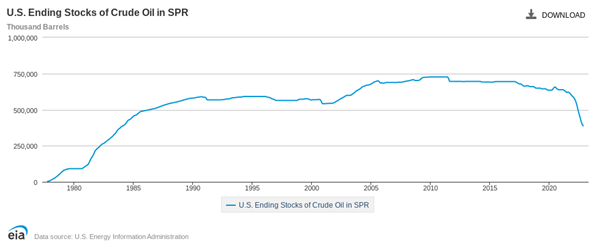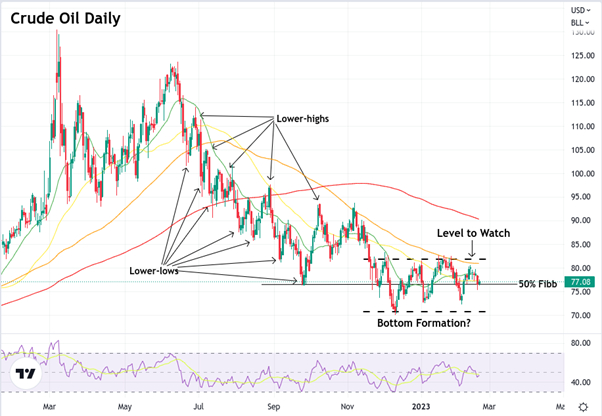At the beginning of February, the OPEC+ Joint Ministerial Monitoring Committee recommended no change to the bloc’s output quota. Group members seem to be pursuing a wait-and-see approach with much global uncertainty surrounding the Chinese reopening, the war in Ukraine, and expectations of slowing global demand as the impact of higher interest rates filter down into their respective economies.
Aramco (TADAWUL:2222) CEO, Amin Nasser, has previously drawn attention to the fact that increased demand from China would erode spare production capacity and that this would impact the ability of energy markets to mitigate unexpected short- and long-term disruptions, as in the case of the Russia-Ukraine conflict.
He also highlighted that underinvestment in hydrocarbons was an issue, and stated that despite Aramco’s own efforts to bring more production capacity online, that “additional investment elsewhere, globally,” would be required to serve global demand.
EIA Reports Builds
Last week’s crude oil inventory report from the US Energy Information Administration (EIA) showed a massive build of 16.3 million barrels to the market’s expectations of a meagre 1.5-million-barrel build. Standing at 471.4 million barrels, U.S. crude oil inventories are currently about 8% higher than their five-year average. This is also the eighth consecutive report in which there have been overall inventory builds.
Cushing Oklahoma reported a build of 659,000 barrels. Meanwhile Gasoline inventories were shown to have grown by a total of 2.3 million barrels, to the market’s expectations of a 1.2-million-barrel build. The only drawdown was reported in distillates, which reported a reduction of inventories of 1.3 million barrels, versus expectations of a 33k drawdown.
What’s particularly intriguing is the reaction to these reports. Builds are bearish for the price of crude oil as it indicates waning demand. Recently we’ve been seeing the price action ignoring these inventory builds, which could signal a stabilisation in crude oil markets, or the approach of a bottom. More on that below.
Russia Cuts Output
Russia recently announced that it will cut its own monthly production output by 5% in response to the price cap on Russian oil imposed by the West. This reduction in output amounts to 500,000 barrels per day and came just days after a new wave of EU sanctions, which include a ban on seaborne Russian crude oil imports. Crude oil markets were up on the day of the announcement, but have since been sanguine about the reported cuts, the price of both WTI and Brent having failed to break above their respective 50-day moving averages.
Biden Announces Another SPR Drawdown
The lack of a fearful response to Russian production cuts is likely to be connected with President Biden’s subsequent announcement that the US would be drawing down a further 26 million barrels from its Strategic Petroleum Reverve. 
This could take the US SPR down below the current level of 372 million barrels, which is the lowest the reserve has been allowed to fall since 1983. The merits of this approach have been hotly debated, particularly from a US security standpoint, but the US administration seems to want to send an unambiguous message to Russia that it is prepared to fight any attempt by the country to weaponise its oil supplies in a manner similar to the natural gas export cuts made to Europe last year.
Crude Oil Technicals
The technical picture doesn’t appear to currently reflect the fears of Russian cuts, questions of spare capacity in the face of China’s reopening, or recent US economic data that have come in hotter than expected.
What we can see in the price action is a gradual mean reversion of the past 9 months or so, characterised by lower-highs and lower-lows, with every attempt at a rally seemingly capped-off at a major moving average. 
Broadly, the price of Crude Oil WTI Futures does appear to be searching for and finding support in the low $70s, which will give the bulls some reason for excitement. However, for stronger confirmation that the price has in fact reached a temporary bottom, and that further upside is in store at least for the medium term, the bulls will want to see an advance to the mid-$80 region.
This would represent a daily higher-high relative to the peaks we saw in late January, as well as a break above the 100-day moving average. This would also mean that the 50% Fibonacci retracement (taking December’s swing low and January’s swing high) at around $76.5 has been respected as support, which recent price action appears to be doing. This level also coincides with September’s bottom, which was followed by a 22% rally, and is currently right in the middle of the range that crude oil has been trading in since November of last year.
Keep an eye on $81.5 as resistance and $70.5 as support. A break above the former could be the first confirmation of a trend change, whereas a break below the latter could signal a continuation of the existing bearish trend.
***
*Any opinions made in this material are personal to the author and do not reflect the opinion of HYCM. This material is considered a marketing communication and should not be construed as containing investment advice or an investment recommendation, or an offer of or solicitation for any transactions in financial instruments. Past performance is not a guarantee of or prediction of future performance. HYCM does not take into account your personal investment objectives or financial situation. HYCM makes no representation and assumes no liability as to the accuracy or completeness of the information provided, nor any loss arising from any investment based on a recommendation, forecast, or other information supplied by an employee of HYCM, a third party, or otherwise.
